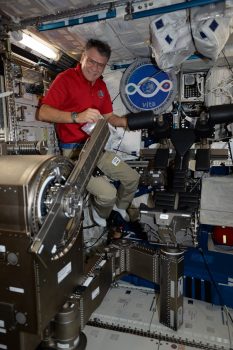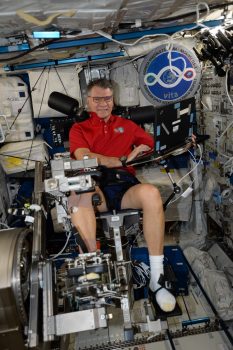Dopo essere arrivato alla Stazione Spaziale nelle prime ore del mattino di Sabato (29 luglio) l’equipaggio ha avuto un giorno di riposo; Paolo Nespoli, astronauta ESA, ha poi iniziato subito a lavorare Domenica 30 luglio.

Paolo con MARES, detto anche La Bestia. Credit: ESA/NASA
Il primo esperimento della lunga lista di attività previste durante la missione VITA era Sarcolab-3 (il cui nome completo è “Myotendinous and Neuromuscular Adaption to Long-term Spaceflight”), il cui obiettivo è capire come i muscoli si adattano e deteriorano in microgravità.
Il fatto che i muscoli si indeboliscano se il corpo rimane per un periodo prolungato in microgravità è ormai un fatto conosciuto: l’esperimento Sarcolab-3, condotto in collaborazione tra ESA, NASA e il Russian Institute of Biomedical Problems, mira a comprendere il perché questo indebolimento accade.
L’esperimento si concentra in modo specifico sui muscoli del polpaccio nel punto in cui questo si connette con il tendine d’Achille: si tratta infatti della parte delle nostre gambe che supporta maggiormente il nostro peso. A Terra questi muscoli sono costantemente sotto sforzo a causa della gravità – ad esempio mentre camminiamo o corriamo – mentre in microgravità si trovano in una condizione di elevato sotto-utilizzo.

Paolo mentre assembla MARES con il collega NASA Randy Bresnik. Credit: ESA/NASA
Paolo e i suoi compagni della Spedizione 52/53 Randy Bresnik (NASA) e Sergey Ryazansky (Roscosmos) stanno tutti partecipando all’esperimento. Prima della loro partenza per lo spazio alcune fibre muscolari sono state prelevate dalle loro gambe e lo stesso sarà fatto al loro ritorno: i campioni verranno quindi confrontati per cercare cambiamenti nelle caratteristiche strutturali e chimiche. Per le misurazioni a bordo gli astronauti hanno a disposizione MARES, il Muscle Atrophy Resistive Exercise System che si trova nel modulo Columbus.
MARES è un macchinario molto complesso in grado di offrire informazioni dettagliate sul comportamento dei muscoli degli astronauti durante la loro permanenza in orbita. Si tratta uno degli strumenti scientifici più grandi tra quelli a bordo e per questo motivo viene riposto quando non in uso. La preparazione e l’assemblaggio di MARES richiedono da soli un intero giorni di lavoro (è possibile vedere un timelapse del montaggio qui).

Paolo mentre misura la risposta dei muscoli del suo polpaccio con MARES. Credit: ESA/NASA
Una volta preparato MARES, Paolo deve fissare al macchinario la sua gamba con una fascia dotata di sensori. Questi sensori hanno il compito di registrare le risposte dei muscoli dell’astronauta che vengono stimolati elettricamente da MARES.
Capire come e perché i muscoli si indeboliscono nello spazio permetterà ai ricercatori di mettere in moto delle contromisure efficaci. Ad oggi gli astronauti hanno un piano di esercizi fisici intenso e costante durante tutta la loro missione (e a Terra) e questo gli permette di rimanere il più possibile in forma mentre si trovano a bordo dell’avamposto spaziale; ogni giorno infatti Paolo e colleghi hanno circa due ore di attività fisica obbligatoria. I risultati di Sarcolab-3 potrebbero aiutare a modificare in meglio le azioni che già si intraprendono per contrastare la perdita di massa muscolare nelle missioni di lunga durata nello spazio.
Questa atrofia muscolare non è caratteristica solo di chi abita nello spazio. I dati di Sarcolab-3 su come e perché i nostri muscoli si indeboliscono in microgravità hanno il potenziale di poter aiutare anche i pazienti a Terra che soffrono di patologie simili.
Non perdetevi i prossimi aggiornamenti sugli esperimenti della missione VITA!



Discussion: no comments